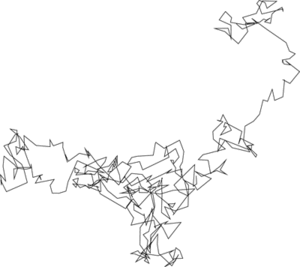The continuous random motion of microscopic solid particles (of about 1 micrometre in diameter) when suspended in a fluid medium. First observed by the botanist Robert Brown (1773–1858) in 1827 when studying pollen particles, it was originally thought to be the manifestation of some vital force. It was later recognized to be a consequence of fluctuations associated with bombardment of the particles by the continually moving molecules of the liquid. The smaller the particles the more extensive is the motion. The effect is also visible in particles of smoke suspended in a still gas. The theory of Brownian motion given by Albert Einstein in 1905 and its subsequent experimental verification soon afterwards were very important in establishing the physical reality of atoms.
http://chemteam.info/Chem-History/Brown-1829.html A transcript of part of Robert Brown’s original 1829 paper
Brownian motion, named after the Scottish botanist Robert Brown (1773–1858), describes the random motions of a particle in a medium. Within mathematics, the term relates to a stochastic process introduced by Norbert Wiener. The Wiener process Wt for t≥0, models the movement of such a particle beginning at the origin at t = 0 and is characterized by the following properties:
(i) W0 = 0
(ii) Future displacements Wt + u – Wt (where u ≥ 0) are independent of Ws where s ≤ t.
(iii) Wt + u – Wt (where u ≥ 0) has normal distribution with mean 0 and variance u.
(iv) Wt is continuous in t.
A continuous-time version of the random walk, named after Robert Brown (1773–1858), a Scottish botanist. In 1827, Brown noticed the erratic movement of pollen grains under water. The first explanation of this motion (in terms of the bombardment of the pollen by the surrounding water molecules) was given by Einstein in 1905. Norbert Wiener provided a concise mathematical description in 1918 and the motion is also called a Wiener process.
Starting from the origin at time 0, the path of a particle is made up of independent increments (in d dimensions) in random directions which are such that its distance from the origin at time t is an observation from a normal distribution with mean 0 and variance proportional to t.
An alternative description is provided by assuming that it is the velocity rather than the position which is changing through time as a consequence of collisions and friction. This model is called the Ornstein–Uhlenbeck process.

Brownian motion. This simulation, in two dimensions, illustrates the typical mixture of apparently random wanderings mixed with apparently purposeful movement.
The continuous random movement of microscopic solid particles (of about 1 micrometre in diameter) when suspended in a fluid medium. First observed by the British botanist Robert Brown (1773–1858) in 1827 when studying pollen particles, it was originally thought to be the manifestation of some vital force. It was later recognized to be a consequence of bombardment of the particles by the continually moving molecules of the liquid. The smaller the particles the more extensive is the motion. The effect is also visible in particles of smoke suspended in a still gas.
http://labs.minutelabs.io/Brownian-Motion/ An interactive video simulation of Brownian motion
http://web.lemoyne.edu/~giunta/perrin.html Jean Perrin’s paper
The small, irregular, and continuous movement of very small particles suspended within a fluid. Particles with a diameter of less than one micrometre (1 μm) have a random movement caused by collisions with other particles. It is named after British botanist Robert Brown (1773–1858) who first noticed the phenomenon while studying pollen particles.
Random movement of small particles dispersed in a colloidal solution or suspension.
A Gaussian process with independent non-overlapping increments. It is named after Robert Brown (1773–1858), a botanist who in 1827 first observed under a microscope the random movement of pollen or dust particles floating in water. The name is used both for this phenomenon and for the mathematical model that describes it; the latter is also known as the Wiener process.